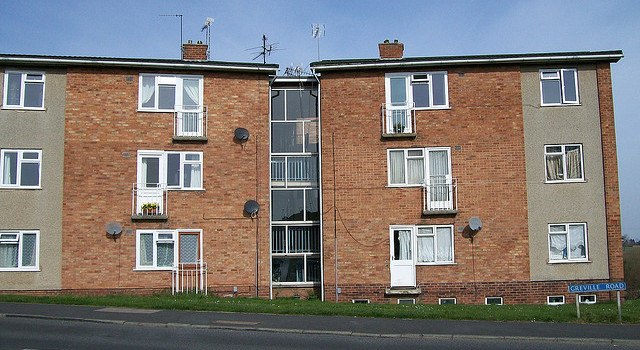
Practical solutions for improve the energy efficiency of your flat
The overall aim of increasing your energy efficiency is to require less heat to keep your home nice and warm. About 60% of our energy costs go on trying to heat the home. Therefore, if you can slow down the speed of which the heat leaves your property, you are obviously going to use less gas and make big savings on your energy bills.
With that in mind, your first aim should be to improve the energy efficiency of the envelope of your home. Now where there is a party wall, roof or floor (i.e. there is a heated space the otherside of one your walls) then you have no problems and these surfaces do not need to be insulated. For example, in my top floor flat, I need not worry about losing heat through the floor since my neighbours downstairs heat their homes. Likewise, I live in a terraced house so neither I nor my neighbours need to insulate our connecting walls. So for me, I only need to concern myself with losing heat through my roof and the front and back walls – but if you live in a ground flat, for example, you need to be aware that you may be losing heat through the floor.
1. Improving Floor insulation
This is only really going to be relevant for ground floor flats, although insulation does have the added bonus of reducing sound transfer so you may decide to insulate the floor of your flat to help stop noise coming from below.
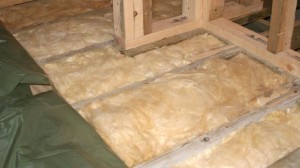 There are two types of floors that you may have – first being solid concrete whereas the second is suspended timber joists. The process of insulating each one of them will be slightly different. With solid concrete floors, insulation material is added on top of the waterproof membrane that sits on the solid floor. To a certain extent, the amount of insulation you put in will be limited to the amount of physical height you are willing to sacrifice. The more insulation you put in the lower your ceilings feel, except if you dig out the solid floor which adds a great deal of expense to the job.
There are two types of floors that you may have – first being solid concrete whereas the second is suspended timber joists. The process of insulating each one of them will be slightly different. With solid concrete floors, insulation material is added on top of the waterproof membrane that sits on the solid floor. To a certain extent, the amount of insulation you put in will be limited to the amount of physical height you are willing to sacrifice. The more insulation you put in the lower your ceilings feel, except if you dig out the solid floor which adds a great deal of expense to the job.
On a timber floor the loss of height is irrelevant as the nature of the floor will allow you to put in a reasonable amount of insulation between the joists – as long as material doesn’t compromise ventilation coming through the floors. Insulating suspended floors is be done by lifting the floorboards and spreading a net over the whole of the floor allowing it to sag between the joists (but not touching the earth below), this then allows the wool insulation to be hung between the joists letting the net act as a sort of hammock.
2. Solid Wall Insulation
If you live in a solid brick house then you may think about getting internal wall insulation. This will mean insulating the insides of your walls by effectively getting them thickened and re-plastered. This sounds very expensive – the good news is that the government’s Green Deal and ECO programmes are there to help part subsidise and offset the costs of these measures – this is a job that will need to be carried out by professionals.
3. Cavity Wall Insulation
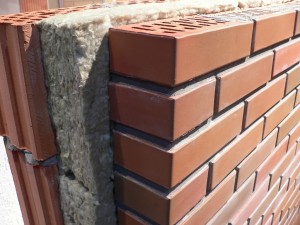 Cavity wall insulation, as mentioned previously, has to be done to the whole of the building – and also needs to be completed by a professional. It is relatively cheap to do, based on the savings it produces and the financial payback should be relatively quick (just a couple of years normally). The process involves drilling holes in the wall every few meters and injecting insulating material into the cavity.
Cavity wall insulation, as mentioned previously, has to be done to the whole of the building – and also needs to be completed by a professional. It is relatively cheap to do, based on the savings it produces and the financial payback should be relatively quick (just a couple of years normally). The process involves drilling holes in the wall every few meters and injecting insulating material into the cavity.
In some cases cavity wall insulation isn’t suitable, and this is normally where the wall in question has a propensity for driving rain, which can lead to damp issues – although a professional will be able to advise on this.
As mentioned previously the best way to do cavity wall insulation is get a buy in from everyone in the flats, since it is much easier to insulate the walls as a whole rather than individual flat walls (as it is pretty much impossible to do this!).
4. Draught Proofing Doors
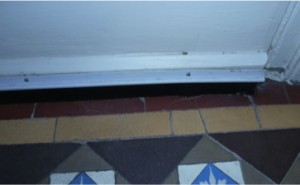 Ground floor or basement flats very often have entrances that are exposed to the outside, which can often let in really cold draughts that can really impact the energy efficiency of the home. It is relatively easy to insulate a door – by draught proofing around the door (draught proofing strips can be bought from a good DIY store), and getting a big draught excluding brush for the bottom of the door and finally installing an Ecoflap on the door flap.
Ground floor or basement flats very often have entrances that are exposed to the outside, which can often let in really cold draughts that can really impact the energy efficiency of the home. It is relatively easy to insulate a door – by draught proofing around the door (draught proofing strips can be bought from a good DIY store), and getting a big draught excluding brush for the bottom of the door and finally installing an Ecoflap on the door flap.
Minimising draughts in the home is key to helping retain the heat generated by your heating system. The draught danger zones are often averted by blocking chimneys with chimney balloons and insulating around single glazed windows (most double glazing will include draught proofing).
If you want an absolutely airtight door unit, you can replace your wooden one with a brand new metallic or uPVC door.
5. Insulating the loft space
If you have access to the loft space then definitely insulate it – 270mm is the recommended thickness of insulation required, but anything over 200mm will do a good job (at about a thickness of 350mm the additional energy saving gains are not worth it). In many cases though you can’t insulate these spaces, so what can you do?
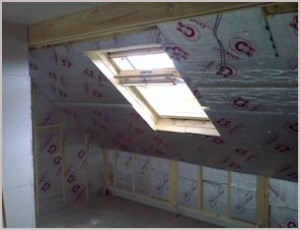 If you have a sloped roof, you can pull the ceiling down and then retrofit Celotex / Kingspan insulating boards in place, before installing new plasterboard and then redecorating. This will normally involve lowering the ceiling, but in some cases you can install the insulating boards between the rafters (where the plasterboard is connected to). Again, if you want to go down this route, please get a professional in to do the work – we don’t want you pulling down your roof unless you know what you are doing!
If you have a sloped roof, you can pull the ceiling down and then retrofit Celotex / Kingspan insulating boards in place, before installing new plasterboard and then redecorating. This will normally involve lowering the ceiling, but in some cases you can install the insulating boards between the rafters (where the plasterboard is connected to). Again, if you want to go down this route, please get a professional in to do the work – we don’t want you pulling down your roof unless you know what you are doing!
What else can you do though if you are looking for a cheaper solution? You can actually use a thermal liner to do the job. Thermal liner is very much like a thick wallpaper (4mm), and is specifically designed to help slow down heat loss. Now I am not going to sit here and pretend that you are going to get the same heat loss performance with thermal liner that you would see with 50 / 100mm insulating boards, but it does a great job nevertheless and it is far simpler to install.
Heating systems in flats
Once we have slowed the rate of heat loss out of the home, we need to consider the heating system. Now if you have access to gas, the easiest way to go is to use a energy efficient boiler – and you are aiming to install one over 89% as a minimum. If you have a non-condensing boiler, now might be the time to consider an upgrade.
As I mentioned earlier though, many flats don’t have access to gas, which means they are forced to heat with electricity.
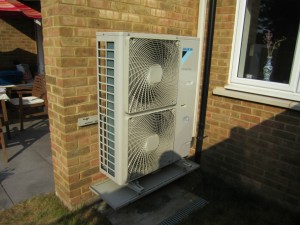 In my opinion there is a clear front-runner here, which is installing an air source heat pump, which runs on electricity. Despite the fact that these are about £8,000 to install, the Renewable Heat Incentive, launching at the end of March 2014, will pay you for every unit of hot water you produce from your system. During the course of the 7 years that you receive the payments, the initial cost of the install should be paid off.
In my opinion there is a clear front-runner here, which is installing an air source heat pump, which runs on electricity. Despite the fact that these are about £8,000 to install, the Renewable Heat Incentive, launching at the end of March 2014, will pay you for every unit of hot water you produce from your system. During the course of the 7 years that you receive the payments, the initial cost of the install should be paid off.
Now, the reason heat pumps are great is that for every unit of electricity they use, they produce 3.5+ units of useful heat. This compares with traditional electric convection heat that produces just one unit of useful heat for each unit of electricity. Despite being a relatively new technology, they essentially work like a fridge in reverse, and I remember at home we had a fridge that is about 20 years + old, so you should have no concern over it breaking down!
If your pockets aren’t that deep (mine certainly aren’t), then you should consider infrared heating – infrared heat is the reason you can feel the warmth of the sun when it is shining on your face on even the coldest winter’s day.
Unlike most heating systems in the UK that take advantage of convection heating, infrared heating panels just produce infrared, which means that they heat up very quickly and you feel the difference almost straight away – there is no more waiting for the radiators to get warm in your flat. This means that they can be on for less time, giving you further savings on your heating bills.
So there you have it – a few practical solutions for increasing the energy efficiency of a flat.
The key things are to try and slow the movement of heat out of the property first and then ensure that your heating system is working well.
As a final note, you should look to install heating controls to ensure your can manage the temperature of the home easily – installing a thermostat (which may cost you £50) can actually save you £50 per degree you lower it, so if you used to heat your house to 24 degrees, taking it down to 22 degrees will save you £100 a year
Pages: 1 2










No Comments yet! Be the first one.